The Role of Social Media in Modern Business Communication Strategies
VerifiedAdded on 2021/06/17
|5
|1489
|71
Essay
AI Summary
This essay explores the transformative impact of social media on business communication. It highlights how social media enhances customer engagement, providing round-the-clock availability and improved marketing through targeted advertising. The essay discusses the shift from traditional advertising to digital marketing, emphasizing cost-effectiveness and real-time performance analysis. Furthermore, it examines how social media boosts brand awareness by facilitating personal-level interactions and building trust with customers, ultimately leading to increased sales and improved market position. The conclusion reinforces the positive influence of social media, emphasizing its role in modern business strategies.
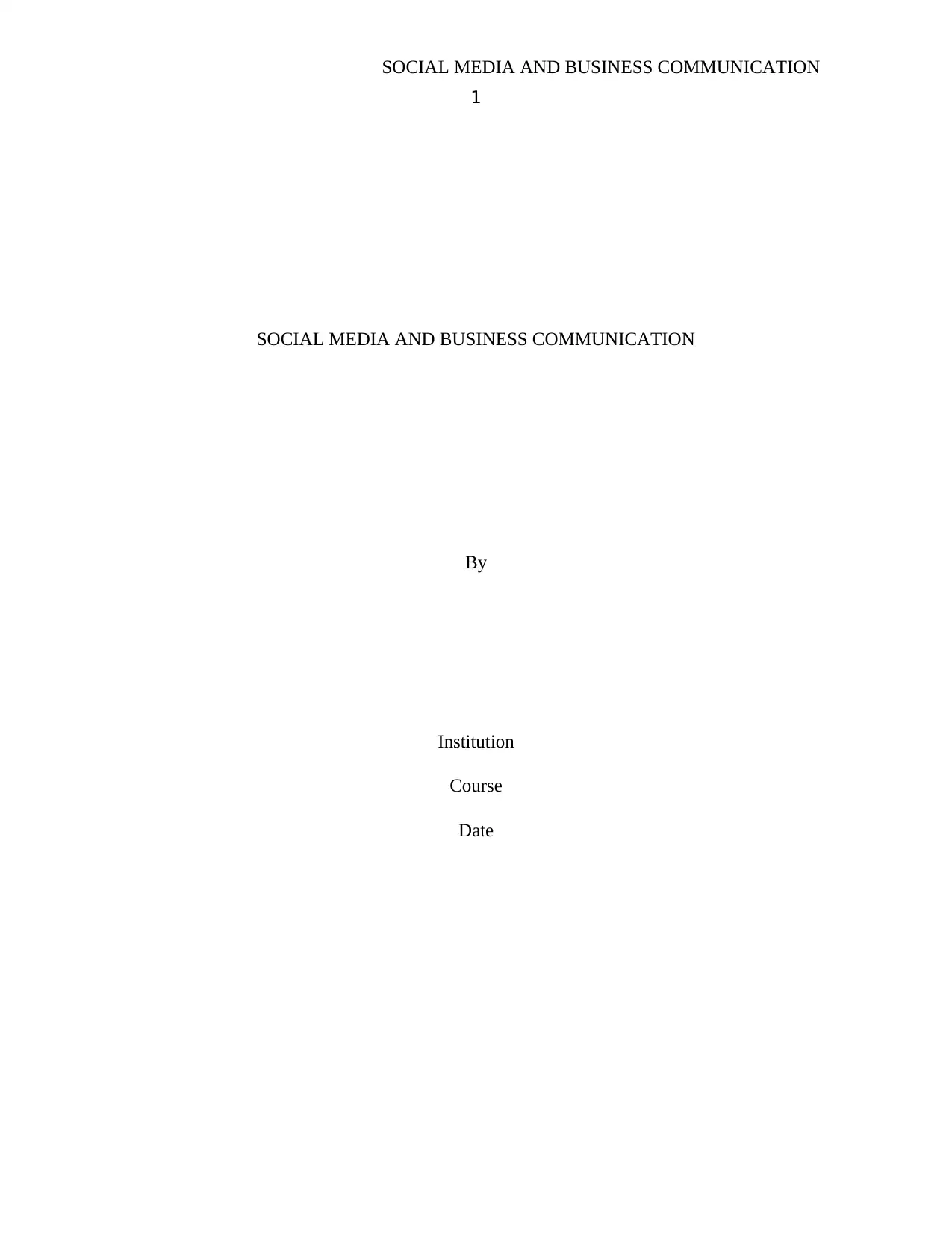
SOCIAL MEDIA AND BUSINESS COMMUNICATION
1
SOCIAL MEDIA AND BUSINESS COMMUNICATION
By
Institution
Course
Date
1
SOCIAL MEDIA AND BUSINESS COMMUNICATION
By
Institution
Course
Date
Paraphrase This Document
Need a fresh take? Get an instant paraphrase of this document with our AI Paraphraser
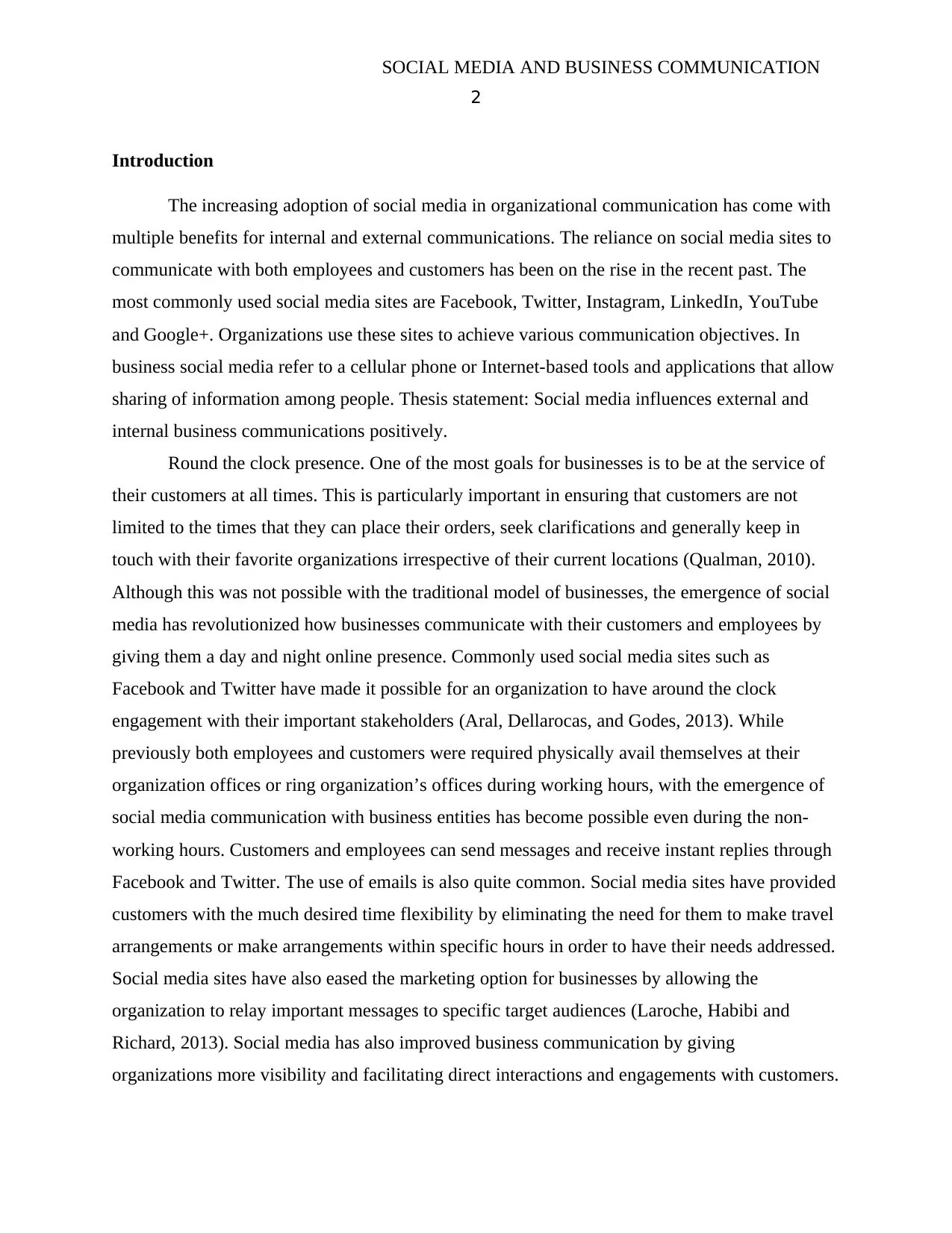
SOCIAL MEDIA AND BUSINESS COMMUNICATION
2
Introduction
The increasing adoption of social media in organizational communication has come with
multiple benefits for internal and external communications. The reliance on social media sites to
communicate with both employees and customers has been on the rise in the recent past. The
most commonly used social media sites are Facebook, Twitter, Instagram, LinkedIn, YouTube
and Google+. Organizations use these sites to achieve various communication objectives. In
business social media refer to a cellular phone or Internet-based tools and applications that allow
sharing of information among people. Thesis statement: Social media influences external and
internal business communications positively.
Round the clock presence. One of the most goals for businesses is to be at the service of
their customers at all times. This is particularly important in ensuring that customers are not
limited to the times that they can place their orders, seek clarifications and generally keep in
touch with their favorite organizations irrespective of their current locations (Qualman, 2010).
Although this was not possible with the traditional model of businesses, the emergence of social
media has revolutionized how businesses communicate with their customers and employees by
giving them a day and night online presence. Commonly used social media sites such as
Facebook and Twitter have made it possible for an organization to have around the clock
engagement with their important stakeholders (Aral, Dellarocas, and Godes, 2013). While
previously both employees and customers were required physically avail themselves at their
organization offices or ring organization’s offices during working hours, with the emergence of
social media communication with business entities has become possible even during the non-
working hours. Customers and employees can send messages and receive instant replies through
Facebook and Twitter. The use of emails is also quite common. Social media sites have provided
customers with the much desired time flexibility by eliminating the need for them to make travel
arrangements or make arrangements within specific hours in order to have their needs addressed.
Social media sites have also eased the marketing option for businesses by allowing the
organization to relay important messages to specific target audiences (Laroche, Habibi and
Richard, 2013). Social media has also improved business communication by giving
organizations more visibility and facilitating direct interactions and engagements with customers.
2
Introduction
The increasing adoption of social media in organizational communication has come with
multiple benefits for internal and external communications. The reliance on social media sites to
communicate with both employees and customers has been on the rise in the recent past. The
most commonly used social media sites are Facebook, Twitter, Instagram, LinkedIn, YouTube
and Google+. Organizations use these sites to achieve various communication objectives. In
business social media refer to a cellular phone or Internet-based tools and applications that allow
sharing of information among people. Thesis statement: Social media influences external and
internal business communications positively.
Round the clock presence. One of the most goals for businesses is to be at the service of
their customers at all times. This is particularly important in ensuring that customers are not
limited to the times that they can place their orders, seek clarifications and generally keep in
touch with their favorite organizations irrespective of their current locations (Qualman, 2010).
Although this was not possible with the traditional model of businesses, the emergence of social
media has revolutionized how businesses communicate with their customers and employees by
giving them a day and night online presence. Commonly used social media sites such as
Facebook and Twitter have made it possible for an organization to have around the clock
engagement with their important stakeholders (Aral, Dellarocas, and Godes, 2013). While
previously both employees and customers were required physically avail themselves at their
organization offices or ring organization’s offices during working hours, with the emergence of
social media communication with business entities has become possible even during the non-
working hours. Customers and employees can send messages and receive instant replies through
Facebook and Twitter. The use of emails is also quite common. Social media sites have provided
customers with the much desired time flexibility by eliminating the need for them to make travel
arrangements or make arrangements within specific hours in order to have their needs addressed.
Social media sites have also eased the marketing option for businesses by allowing the
organization to relay important messages to specific target audiences (Laroche, Habibi and
Richard, 2013). Social media has also improved business communication by giving
organizations more visibility and facilitating direct interactions and engagements with customers.
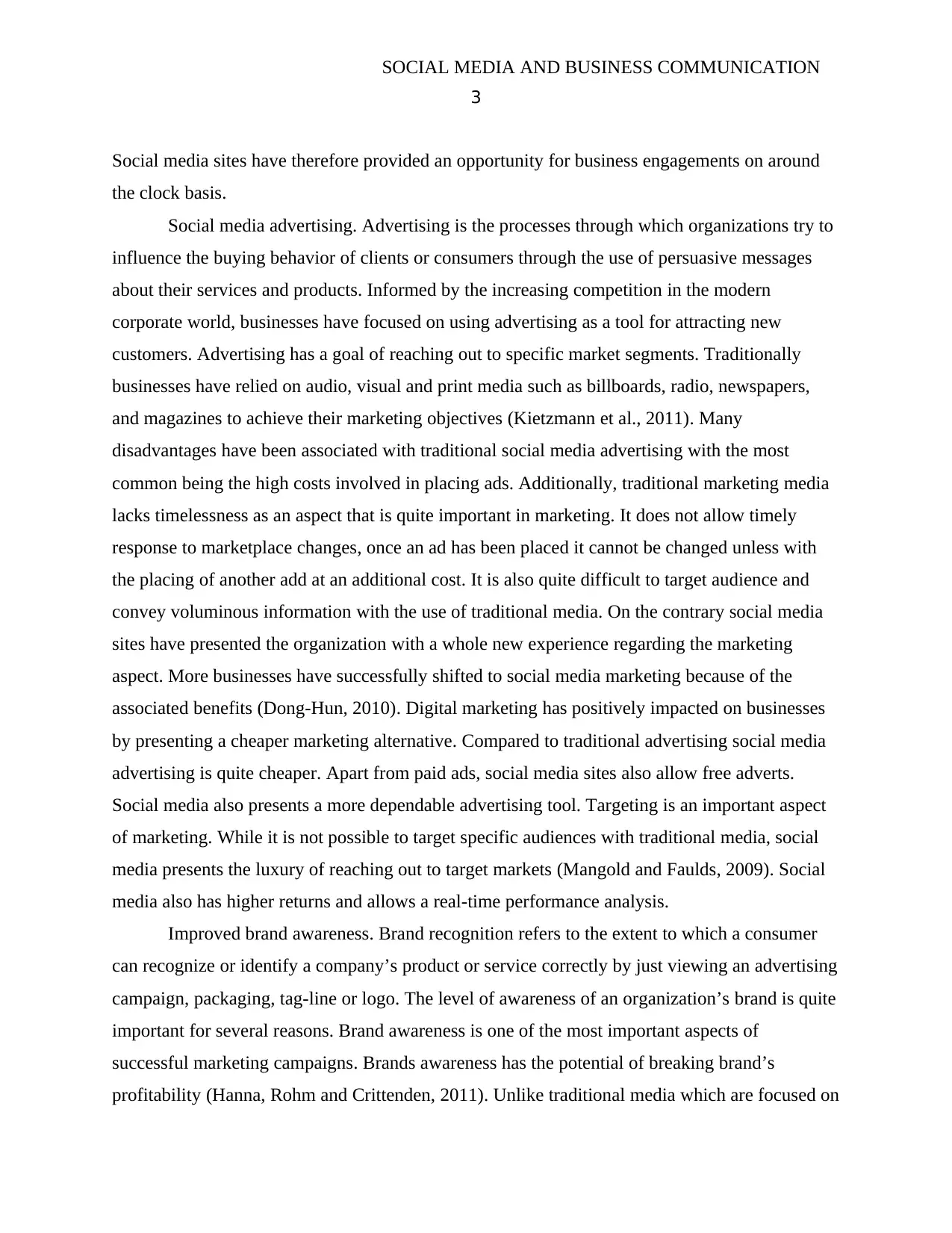
SOCIAL MEDIA AND BUSINESS COMMUNICATION
3
Social media sites have therefore provided an opportunity for business engagements on around
the clock basis.
Social media advertising. Advertising is the processes through which organizations try to
influence the buying behavior of clients or consumers through the use of persuasive messages
about their services and products. Informed by the increasing competition in the modern
corporate world, businesses have focused on using advertising as a tool for attracting new
customers. Advertising has a goal of reaching out to specific market segments. Traditionally
businesses have relied on audio, visual and print media such as billboards, radio, newspapers,
and magazines to achieve their marketing objectives (Kietzmann et al., 2011). Many
disadvantages have been associated with traditional social media advertising with the most
common being the high costs involved in placing ads. Additionally, traditional marketing media
lacks timelessness as an aspect that is quite important in marketing. It does not allow timely
response to marketplace changes, once an ad has been placed it cannot be changed unless with
the placing of another add at an additional cost. It is also quite difficult to target audience and
convey voluminous information with the use of traditional media. On the contrary social media
sites have presented the organization with a whole new experience regarding the marketing
aspect. More businesses have successfully shifted to social media marketing because of the
associated benefits (Dong-Hun, 2010). Digital marketing has positively impacted on businesses
by presenting a cheaper marketing alternative. Compared to traditional advertising social media
advertising is quite cheaper. Apart from paid ads, social media sites also allow free adverts.
Social media also presents a more dependable advertising tool. Targeting is an important aspect
of marketing. While it is not possible to target specific audiences with traditional media, social
media presents the luxury of reaching out to target markets (Mangold and Faulds, 2009). Social
media also has higher returns and allows a real-time performance analysis.
Improved brand awareness. Brand recognition refers to the extent to which a consumer
can recognize or identify a company’s product or service correctly by just viewing an advertising
campaign, packaging, tag-line or logo. The level of awareness of an organization’s brand is quite
important for several reasons. Brand awareness is one of the most important aspects of
successful marketing campaigns. Brands awareness has the potential of breaking brand’s
profitability (Hanna, Rohm and Crittenden, 2011). Unlike traditional media which are focused on
3
Social media sites have therefore provided an opportunity for business engagements on around
the clock basis.
Social media advertising. Advertising is the processes through which organizations try to
influence the buying behavior of clients or consumers through the use of persuasive messages
about their services and products. Informed by the increasing competition in the modern
corporate world, businesses have focused on using advertising as a tool for attracting new
customers. Advertising has a goal of reaching out to specific market segments. Traditionally
businesses have relied on audio, visual and print media such as billboards, radio, newspapers,
and magazines to achieve their marketing objectives (Kietzmann et al., 2011). Many
disadvantages have been associated with traditional social media advertising with the most
common being the high costs involved in placing ads. Additionally, traditional marketing media
lacks timelessness as an aspect that is quite important in marketing. It does not allow timely
response to marketplace changes, once an ad has been placed it cannot be changed unless with
the placing of another add at an additional cost. It is also quite difficult to target audience and
convey voluminous information with the use of traditional media. On the contrary social media
sites have presented the organization with a whole new experience regarding the marketing
aspect. More businesses have successfully shifted to social media marketing because of the
associated benefits (Dong-Hun, 2010). Digital marketing has positively impacted on businesses
by presenting a cheaper marketing alternative. Compared to traditional advertising social media
advertising is quite cheaper. Apart from paid ads, social media sites also allow free adverts.
Social media also presents a more dependable advertising tool. Targeting is an important aspect
of marketing. While it is not possible to target specific audiences with traditional media, social
media presents the luxury of reaching out to target markets (Mangold and Faulds, 2009). Social
media also has higher returns and allows a real-time performance analysis.
Improved brand awareness. Brand recognition refers to the extent to which a consumer
can recognize or identify a company’s product or service correctly by just viewing an advertising
campaign, packaging, tag-line or logo. The level of awareness of an organization’s brand is quite
important for several reasons. Brand awareness is one of the most important aspects of
successful marketing campaigns. Brands awareness has the potential of breaking brand’s
profitability (Hanna, Rohm and Crittenden, 2011). Unlike traditional media which are focused on
⊘ This is a preview!⊘
Do you want full access?
Subscribe today to unlock all pages.

Trusted by 1+ million students worldwide
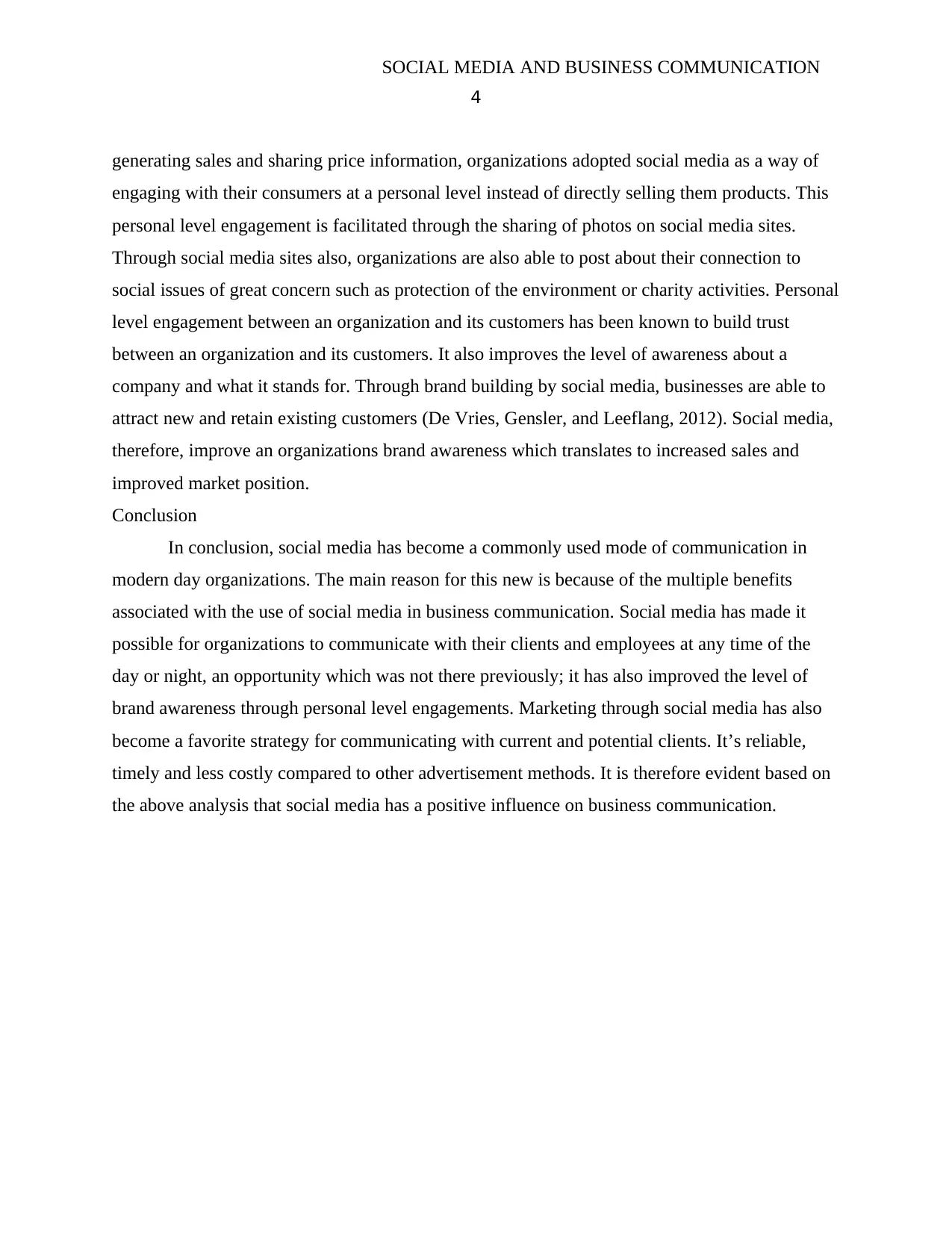
SOCIAL MEDIA AND BUSINESS COMMUNICATION
4
generating sales and sharing price information, organizations adopted social media as a way of
engaging with their consumers at a personal level instead of directly selling them products. This
personal level engagement is facilitated through the sharing of photos on social media sites.
Through social media sites also, organizations are also able to post about their connection to
social issues of great concern such as protection of the environment or charity activities. Personal
level engagement between an organization and its customers has been known to build trust
between an organization and its customers. It also improves the level of awareness about a
company and what it stands for. Through brand building by social media, businesses are able to
attract new and retain existing customers (De Vries, Gensler, and Leeflang, 2012). Social media,
therefore, improve an organizations brand awareness which translates to increased sales and
improved market position.
Conclusion
In conclusion, social media has become a commonly used mode of communication in
modern day organizations. The main reason for this new is because of the multiple benefits
associated with the use of social media in business communication. Social media has made it
possible for organizations to communicate with their clients and employees at any time of the
day or night, an opportunity which was not there previously; it has also improved the level of
brand awareness through personal level engagements. Marketing through social media has also
become a favorite strategy for communicating with current and potential clients. It’s reliable,
timely and less costly compared to other advertisement methods. It is therefore evident based on
the above analysis that social media has a positive influence on business communication.
4
generating sales and sharing price information, organizations adopted social media as a way of
engaging with their consumers at a personal level instead of directly selling them products. This
personal level engagement is facilitated through the sharing of photos on social media sites.
Through social media sites also, organizations are also able to post about their connection to
social issues of great concern such as protection of the environment or charity activities. Personal
level engagement between an organization and its customers has been known to build trust
between an organization and its customers. It also improves the level of awareness about a
company and what it stands for. Through brand building by social media, businesses are able to
attract new and retain existing customers (De Vries, Gensler, and Leeflang, 2012). Social media,
therefore, improve an organizations brand awareness which translates to increased sales and
improved market position.
Conclusion
In conclusion, social media has become a commonly used mode of communication in
modern day organizations. The main reason for this new is because of the multiple benefits
associated with the use of social media in business communication. Social media has made it
possible for organizations to communicate with their clients and employees at any time of the
day or night, an opportunity which was not there previously; it has also improved the level of
brand awareness through personal level engagements. Marketing through social media has also
become a favorite strategy for communicating with current and potential clients. It’s reliable,
timely and less costly compared to other advertisement methods. It is therefore evident based on
the above analysis that social media has a positive influence on business communication.
Paraphrase This Document
Need a fresh take? Get an instant paraphrase of this document with our AI Paraphraser
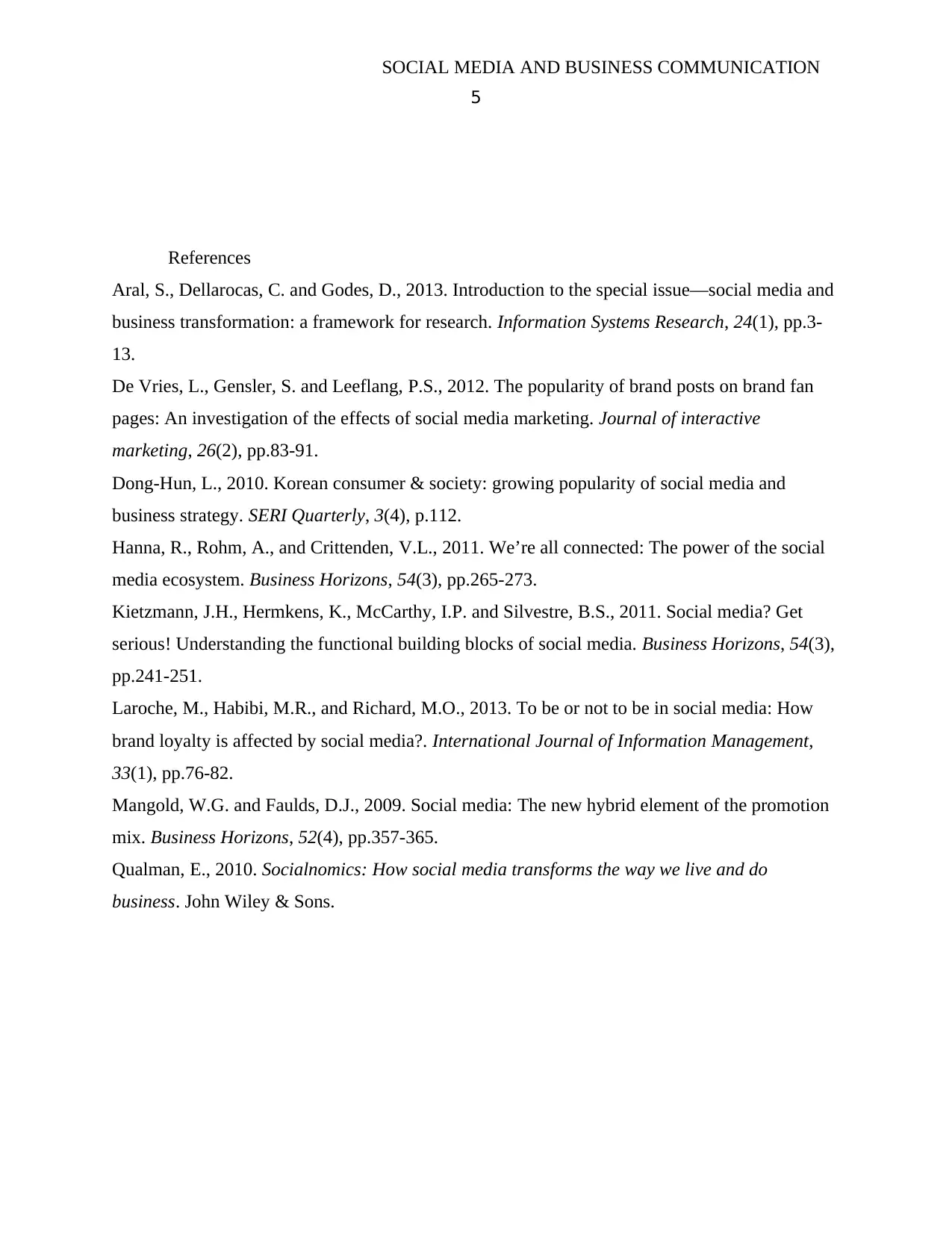
SOCIAL MEDIA AND BUSINESS COMMUNICATION
5
References
Aral, S., Dellarocas, C. and Godes, D., 2013. Introduction to the special issue—social media and
business transformation: a framework for research. Information Systems Research, 24(1), pp.3-
13.
De Vries, L., Gensler, S. and Leeflang, P.S., 2012. The popularity of brand posts on brand fan
pages: An investigation of the effects of social media marketing. Journal of interactive
marketing, 26(2), pp.83-91.
Dong-Hun, L., 2010. Korean consumer & society: growing popularity of social media and
business strategy. SERI Quarterly, 3(4), p.112.
Hanna, R., Rohm, A., and Crittenden, V.L., 2011. We’re all connected: The power of the social
media ecosystem. Business Horizons, 54(3), pp.265-273.
Kietzmann, J.H., Hermkens, K., McCarthy, I.P. and Silvestre, B.S., 2011. Social media? Get
serious! Understanding the functional building blocks of social media. Business Horizons, 54(3),
pp.241-251.
Laroche, M., Habibi, M.R., and Richard, M.O., 2013. To be or not to be in social media: How
brand loyalty is affected by social media?. International Journal of Information Management,
33(1), pp.76-82.
Mangold, W.G. and Faulds, D.J., 2009. Social media: The new hybrid element of the promotion
mix. Business Horizons, 52(4), pp.357-365.
Qualman, E., 2010. Socialnomics: How social media transforms the way we live and do
business. John Wiley & Sons.
5
References
Aral, S., Dellarocas, C. and Godes, D., 2013. Introduction to the special issue—social media and
business transformation: a framework for research. Information Systems Research, 24(1), pp.3-
13.
De Vries, L., Gensler, S. and Leeflang, P.S., 2012. The popularity of brand posts on brand fan
pages: An investigation of the effects of social media marketing. Journal of interactive
marketing, 26(2), pp.83-91.
Dong-Hun, L., 2010. Korean consumer & society: growing popularity of social media and
business strategy. SERI Quarterly, 3(4), p.112.
Hanna, R., Rohm, A., and Crittenden, V.L., 2011. We’re all connected: The power of the social
media ecosystem. Business Horizons, 54(3), pp.265-273.
Kietzmann, J.H., Hermkens, K., McCarthy, I.P. and Silvestre, B.S., 2011. Social media? Get
serious! Understanding the functional building blocks of social media. Business Horizons, 54(3),
pp.241-251.
Laroche, M., Habibi, M.R., and Richard, M.O., 2013. To be or not to be in social media: How
brand loyalty is affected by social media?. International Journal of Information Management,
33(1), pp.76-82.
Mangold, W.G. and Faulds, D.J., 2009. Social media: The new hybrid element of the promotion
mix. Business Horizons, 52(4), pp.357-365.
Qualman, E., 2010. Socialnomics: How social media transforms the way we live and do
business. John Wiley & Sons.
1 out of 5
Related Documents
Your All-in-One AI-Powered Toolkit for Academic Success.
+13062052269
info@desklib.com
Available 24*7 on WhatsApp / Email
![[object Object]](/_next/static/media/star-bottom.7253800d.svg)
Unlock your academic potential
Copyright © 2020–2025 A2Z Services. All Rights Reserved. Developed and managed by ZUCOL.





